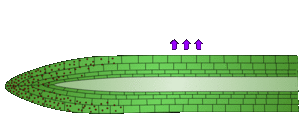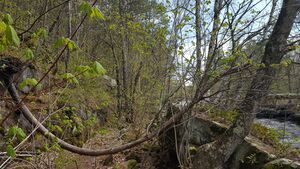انتحاء أرضي
Gravitropism (also known as geotropism) is a coordinated process of differential growth by a plant in response to gravity pulling on it. It also occurs in fungi. Gravity can be either "artificial gravity" or natural gravity. It is a general feature of all higher and many lower plants as well as other organisms. Charles Darwin was one of the first to scientifically document that roots show positive gravitropism and stems show negative gravitropism.[1] That is, roots grow in the direction of gravitational pull (i.e., downward) and stems grow in the opposite direction (i.e., upwards). This behavior can be easily demonstrated with any potted plant. When laid onto its side, the growing parts of the stem begin to display negative gravitropism, growing (biologists say, turning; see tropism) upwards. Herbaceous (non-woody) stems are capable of a degree of actual bending, but most of the redirected movement occurs as a consequence of root or stem growth outside. The mechanism is based on the Cholodny–Went model which was proposed in 1927, and has since been modified.[2] Although the model has been criticized and continues to be refined, it has largely stood the test of time.[3]
في الجذور
![[this image is incorrect! the high auxin is always on the opposite side of the tropic movement!]](/w/images/thumb/b/bc/Gravitropism_in_Roots.gif/300px-Gravitropism_in_Roots.gif)
In shoots

Gravity-sensing mechanisms
Statoliths
Modulation by phytochrome
Compensation

Gravitropic mutants
انظر أيضاً
- Amyloplast – starch organelle involved in sensing gravitropism
- Astrobotany – the field of science concerned with plants in a spaceflight environment
- Clinostat – a device used to the effects of gravitational pull
- Random positioning machine – a device used to negate the effects of gravitational pull
- Free fall machine – a device used to negate the effects of gravitational pull
- Large diameter centrifuge – a device used to create a hyper-gravity pull
- Prolonged sine – reaction of plants to turning from their usual vertical orientation
المصادر
- ^ Darwin, Charles; Darwin, Francisc (1881). The power of movement in plants. New York: D. Appleton and Company. Retrieved 24 April 2018.
- ^ Haga, Ken; Takano, Makoto; Neumann, Ralf; Iino, Moritoshi (January 1, 2005). "The Rice COLEOPTILE PHOTOTROPISM1 Gene Encoding an Ortholog of Arabidopsis NPH3 Is Required for Phototropism of Coleoptiles and Lateral Translocation of Auxin(W)". Plant Cell. 17 (1): 103–15. doi:10.1105/tpc.104.028357. PMC 544493. PMID 15598797. Retrieved 2012-06-22.[dead link] – via HighBeam (يتطلب اشتراك)
- ^ "Phototropism – Cholodny-went Theory". JRank. Retrieved 2012-05-29.
- ^ خطأ استشهاد: وسم
<ref>غير صحيح؛ لا نص تم توفيره للمراجع المسماة:5 - ^ "Gravitropism Lesson". herbarium.desu.edu. Retrieved 2018-07-08.

